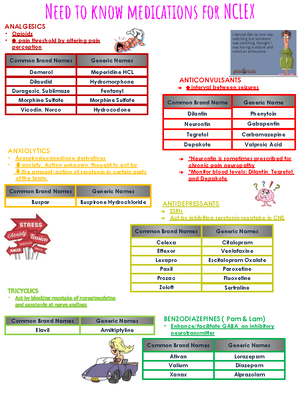- Information
- AI Chat
Was this document helpful?
Cc 7 trauma
Course: Critical Care (408)
18 Documents
Students shared 18 documents in this course
University: Loma Linda University
Was this document helpful?

Trauma Blunt Trauma
injury without opening/penetrating
the skin
diagnosis can be difficult d/t extent
of injuries less obvious than
penetrating trauma
blunt trauma more life threatening
Common forces of Blunt Trauma
acceleration/deceleration
increased velocity/speed of a
moving object sudden
deceleration
shearing
two opposite parallel forces
applied to tissue
compression
squeezing inward pressure
applied to tissues
Penetrating Trauma
injuries penetrate skin damage in
internal structure
diagnosis can be misleading –
condition of outside wound
doesn’t reflect extent of internal
injury
bullets can create holes/cavities
5-30 times larger than diameter of
bullet
Trauma Triage
screening of trauma pt to
determine priority needs
EMS - community | RN –
hospital
Phases of Care – trimodal
distribution of trauma deaths
First Peak – immediate (50%
die)
seconds/minutes after injury
| at the scene or on the way
to medical facility
victims die before
treatment
injuries: brain/brainstem
laceration, high SCI, injury
to heart/aorta/large vessels
Second Peak – early (30%
die)
golden hour (time from
injury to definitive care) for
critically injured try to get
to ED/OR to get treated
ASAP
minutes/hours after injury |
ED or OR
injury: usually
hemorrhage related,
ruptured spleen, liver
laceration, pelvic fracture,
hemopneumothorax
Third Peak – late (20% die)
days/weeks after injury |
critical care unit
injury: complications -
sepsis, multi-organ failure
(MODS)
leading cause of death for all
age groups < 44 y/o
25% admissions to (ED) r/t
trauma
most common trauma
1st: motor vehicle accident
(MVA)
2nd: falls
In 2014, 31% of all traffic
fatalities in US were linked
to alcohol-impairment
trauma is a surgical disease
Mechanisms of Injury
external force of energy
impacts the body
structural/physiologic injury
understanding mechanism of
injury helps nurses/providers
to anticipate & predict
potential internal injuries
Trauma Nursing
Management – continuum
of 6 phases
pre-hospital resuscitation
hospital resuscitation
definitive care & operative
phase (OR)
critical care – SBAR (ICU)
intermediate care (stepdown)
rehabilitation
Hospital Resuscitation Resuscitation Phase
hypovolemic shock most common
Shock in trauma pts
2 large bore IV catheters
14-16 gauge
blood drawn
IV fluids administered rapidly
normal saline (NS)
lactated ringers (LR)
fluid warmer if fluid given rapidly
O-negative blood or type specific
blood
if not responsive to LR
additional:
foley cathether & orogastric tube
3 S
stop bleeding
splint fractures
stabilize pelvis
(a lot vessels, prevent bleeding)
Secondary Survey
F: Full set of vital
signs/focused adjuncts
includes cardiac
monitor/EKG
family presence
focused assessment w/
sonography for trauma
(FAST exam)
G: Give comfort measures
verbal reassurance & touch
pain management (pharm &
non-pharm)
H: History & Head-to-toe
assessment (AMPLE)
A: allergies
M: medications
P: past medical illness /
pregnancy
L: last meal (in case of
intubation)
E: Events immediately
2 phases: primary &
secondary assessment
both can be done in several
mins unless resuscitative
measures required
Primary Survey
A: airway maintenance
w/ cervical spine protection
B: breathing (tension or
hemothorax) and ventilation
C: circulation (hypotensive
shock)
control hemorrhage
D: disability
check neurologic status
E: expose/environmental
controls
remove clothing
keep the patient warm













